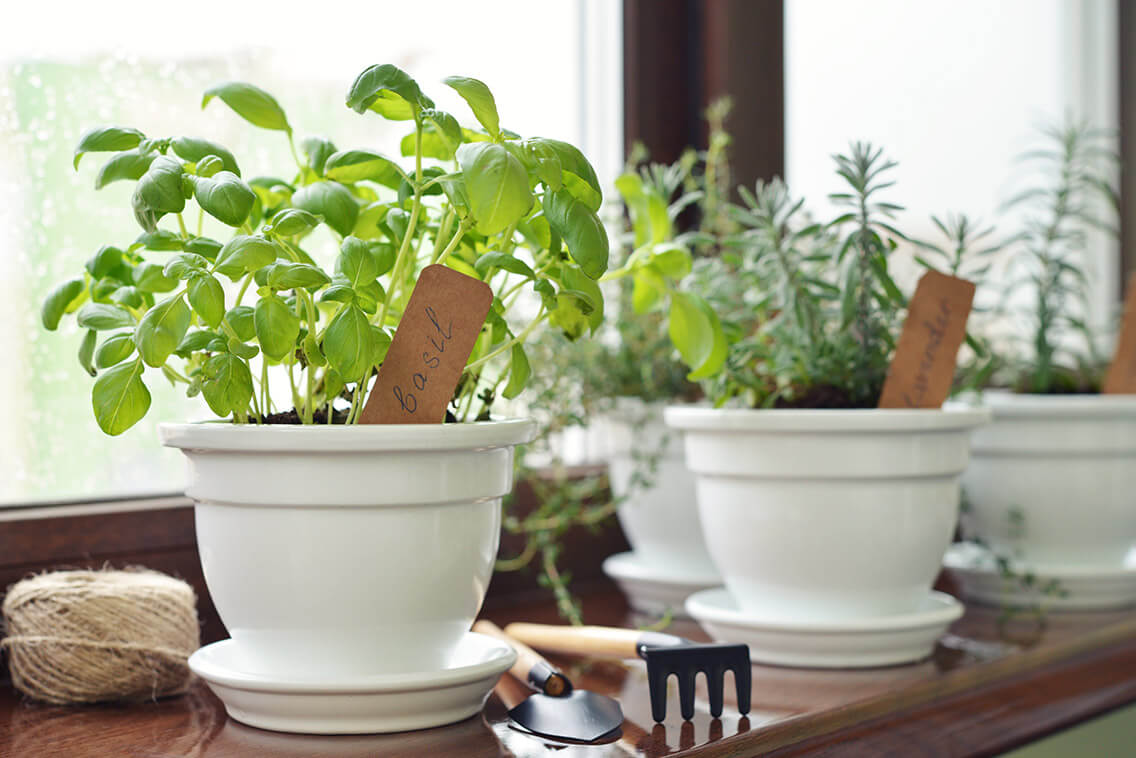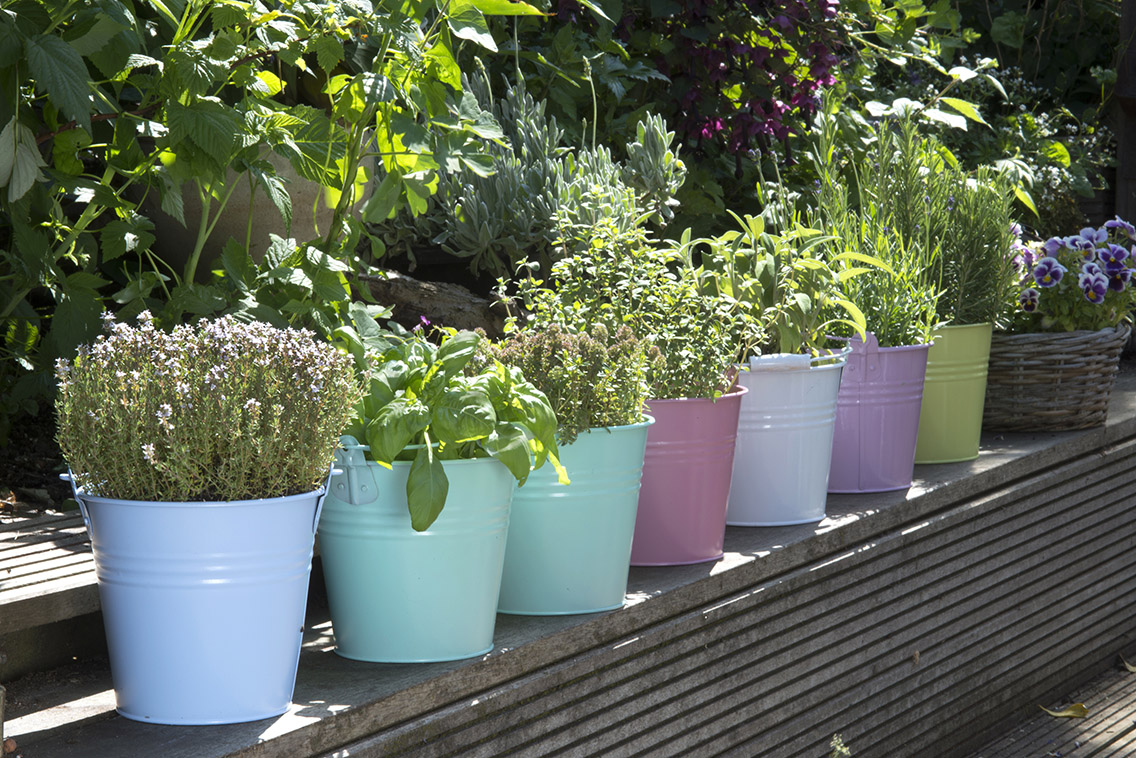No Land? No Problem. You Can Still Get Growing with Containers!
Don’t let a lack of acreage stop you from flexing your green thumb. Our potted-plant primer makes it possible to garden just about anywhere.
No Land? No Problem. You Can Still Get Growing with Containers!
Don’t let a lack of acreage stop you from flexing your green thumb. Our potted-plant primer makes it possible to garden just about anywhere.

Does the Container Matter?
There are hefty price differences among pots. You might think that a beautiful terra cotta or galvanized steel container possesses superior horticultural powers. You’d be wrong. “It’s not really going to make a difference,” says Sheperd. If you want an expensive glazed ceramic pot because it looks great, fine, but Sheperd actually recommends a cheap all-purpose bucket of the sort you can get at Home Depot for under $3. (More on that below.)
The key to successful container gardening is not the container’s material, but its size. “Bigger means more soil volume, which means more root mass, which means the roots can hold more nutrients and water,” says Sheperd. Furthermore, different plants have different needs. In general, herbs, greens, and lettuces require minimal space. But each tomato, pepper, zucchini, cucumber, or bean plant should get its own 5-gallon container.
How to Trick Out Your Container
The reason Sheperd prefers a cheap all-purpose bucket is because she gets to determine the location of the drainage holes, by drilling a few around the sides, several inches up from the bottom. (Traditionally, drainage holes are located on the pot’s bottom.) To create a reservoir at the bottom of the bucket, she pours in regular chunky gravel just above the level of the holes, then lays down a layer of weed-block fabric before adding soil, to prevent the soil from clogging the reservoir. The end result: The plant remains well-irrigated, and you water it less.

The organic seeds packets included with some Seed Phytonutrient products – sweet basil, harvest thyme, and lemon basil – can all be grown in containers. Give it a shot!
But What About the Soil?
Though Sheperd builds her own soil with coconut husks, cow manure, and all kinds of other things, she says you can certainly make due with a good bagged organic mix. She also recommends using organic fertilizer: compost if you have access to it, or an off-the-shelf version. “Dr. Earth is a good fertilizer brand,” says Shepherd, who warns against applying too much. “Over-fertilizing is just as bad as under-fertilizing. I tell people to think of it like salting soup.”
Okay, So What Should You Grow?
“If you’re gardening in containers, then your limiting factor is probably space,” says Shepherd, “so I would focus on plants that produce a lot per square foot.” Translation: Root vegetables; carrots, beets, onions, and radishes aren’t a great bet, because one seed equals one vegetable. Compare that with peppers, lettuces, herbs, and flowers like calendula and zinnias, which you can pick multiple times per season. Most herbs will also live happily inside come winter, in a sunny, south-facing window.
—
How to Water a Container Plant
Never, ever drizzle water over the top of the plant: If the leaves get and stay wet, they can develop mold and other problems. Instead, water the plant at soil level. Adds Shepherd: If you have a hose nearby, it’s worth it to put in an inexpensive irrigation system.”
A Final Note on Proper Placement
“When I’m helping someone set up a container garden, the first thing I look at is sunlight,” says Sheperd, who prefers south-facing light because it shines brightest in the morning. Harsh, broiling afternoon sun can burn plants and evaporate water too quickly. In containers, the problem is amplified, adds Shepherd: “There’s less soil volume, so things do dry out more quickly.”
Love & Carrots is a DC-based home gardening company that helps urbanites set up gardens in the strange and difficult spaces.
SaveSaveSaveSave
Follow us
This work is licensed under a Creative Commons Attribution-NoDerivatives 4.0 International License.
Want to republish a Modern Farmer story?
We are happy for Modern Farmer stories to be shared, and encourage you to republish our articles for your audience. When doing so, we ask that you follow these guidelines:
Please credit us and our writers
For the author byline, please use “Author Name, Modern Farmer.” At the top of our stories, if on the web, please include this text and link: “This story was originally published by Modern Farmer.”
Please make sure to include a link back to either our home page or the article URL.
At the bottom of the story, please include the following text:
“Modern Farmer is a nonprofit initiative dedicated to raising awareness and catalyzing action at the intersection of food, agriculture, and society. Read more at <link>Modern Farmer</link>.”
Use our widget
We’d like to be able to track our stories, so we ask that if you republish our content, you do so using our widget (located on the left hand side of the article). The HTML code has a built-in tracker that tells us the data and domain where the story was published, as well as view counts.
Check the image requirements
It’s your responsibility to confirm you're licensed to republish images in our articles. Some images, such as those from commercial providers, don't allow their images to be republished without permission or payment. Copyright terms are generally listed in the image caption and attribution. You are welcome to omit our images or substitute with your own. Charts and interactive graphics follow the same rules.
Don’t change too much. Or, ask us first.
Articles must be republished in their entirety. It’s okay to change references to time (“today” to “yesterday”) or location (“Iowa City, IA” to “here”). But please keep everything else the same.
If you feel strongly that a more material edit needs to be made, get in touch with us at [email protected]. We’re happy to discuss it with the original author, but we must have prior approval for changes before publication.
Special cases
Extracts. You may run the first few lines or paragraphs of the article and then say: “Read the full article at Modern Farmer” with a link back to the original article.
Quotes. You may quote authors provided you include a link back to the article URL.
Translations. These require writer approval. To inquire about translation of a Modern Farmer article, contact us at [email protected]
Signed consent / copyright release forms. These are not required, provided you are following these guidelines.
Print. Articles can be republished in print under these same rules, with the exception that you do not need to include the links.
Tag us
When sharing the story on social media, please tag us using the following: - Twitter (@ModFarm) - Facebook (@ModernFarmerMedia) - Instagram (@modfarm)
Use our content respectfully
Modern Farmer is a nonprofit and as such we share our content for free and in good faith in order to reach new audiences. Respectfully,
No selling ads against our stories. It’s okay to put our stories on pages with ads.
Don’t republish our material wholesale, or automatically; you need to select stories to be republished individually.
You have no rights to sell, license, syndicate, or otherwise represent yourself as the authorized owner of our material to any third parties. This means that you cannot actively publish or submit our work for syndication to third party platforms or apps like Apple News or Google News. We understand that publishers cannot fully control when certain third parties automatically summarize or crawl content from publishers’ own sites.
Keep in touch
We want to hear from you if you love Modern Farmer content, have a collaboration idea, or anything else to share. As a nonprofit outlet, we work in service of our community and are always open to comments, feedback, and ideas. Contact us at [email protected].by Dan Nosowitz, Modern Farmer
August 7, 2017
Modern Farmer Weekly
Solutions Hub
Innovations, ideas and inspiration. Actionable solutions for a resilient food system.
ExploreExplore other topics
Share With Us
We want to hear from Modern Farmer readers who have thoughtful commentary, actionable solutions, or helpful ideas to share.
SubmitNecessary cookies are absolutely essential for the website to function properly. This category only includes cookies that ensures basic functionalities and security features of the website. These cookies do not store any personal information.
Any cookies that may not be particularly necessary for the website to function and are used specifically to collect user personal data via analytics, ads, other embedded contents are termed as non-necessary cookies.